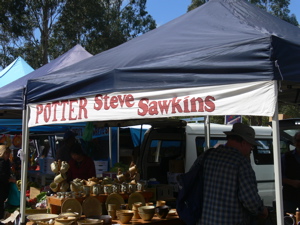Sunday September 23, 2007 5:25 am Lennox Head, NSW Australia
I do not have Internet access at the moment.
A. Morning Musings
5:30 am
There was rain much of the night. But the sky appears to be lightening now. We are planning to have a Sunday brunch with friends in Bangalow and then visit the markets. We are hoping to buy some fresh fruit (passion fruit, bananas, avocados, tomatos) and vegetables as well as see what is new after a year's absense.
I am also hoping to obtain a modem for dial-up that I can plug into my laptop. This would give me internet access and I could attend to a backlog of email. The New York Times crossword puzzles are a nice break in the day. I have now completed about 80 (out of 200).
My cold continues to linger - annoying.
I began reading "Three Dollars" late yesterday. It will be an enjoyable book. I also read the preface and first chapter of the non-fiction book "Why Beauty is Truth" by Ian Stewart. Now to make a few notes.
| Immediate |
Description |
Time |
| Mathematics |
"Why Beauty is Truth: A History of Symmetry" by Ian Stewart |
1 hr |
| Technology |
Try to install software for using dial-up internet access |
2 hr |
| Literature |
"Three Dollars" by Elliot Perlman |
1 hr |
| Mathematics |
Complete exercises p. 45 - 46 from "The Mathematics Survival Kit" |
1 hr |
C. Actual Learning Activities
6:00 am
Mathematics 62
September 23, 2007
6:00 am
Here are a few quotes from "Why Beauty is Truth" by Ian Stewart.
Preface
- "Galois ... invented a language to describe symmetry in mathematical structures. ... that language, known as 'group theory' " [p. ix]
- This sentence really worked for me. The key phrase was "mathematical structures". I now realize that group theory is about mathematical structures and in particular about the types of symmetry that they may, or may not, possess.
- "Symmetry is ... a special kind of transformation - a way to move an object. If the object looks the same after being transformed, then the transformation concerned is a symmetry."
[p. ix]
- This is different than the popular idea that a symmetry is a property of an object. I have seen this distinction before and am familiar with it.
- "The profoundly beautiful and indispensible concept of symmetry that mathematicians and physicists use today arrived via algebra. Much of this book, therefore, describes the search for solutions of algebraic equations." [p. x]
- I have another book (back home in Lethbridge) called "The Equation That Couldn't Be Solved" that describes this same history. But I have not yet given it a careful read and would not be able to describe the various people and steps that were followed. It looks like Stewart will give me another go at this. This time, I will pay attention to the details and the underlying mathematical ideas. I am actually quite excited at the moment. I can see light at the end of the tunnel and that the idea of symmetry is one of the keystone ideas in all of mathematics and science.
- "Beginning in the tenth century BCE and reaching its climax with Galois in the early nineteenth century, the narrative retraces the step-by-step conquest of equations." [p. xi]
- We have three thousand years of history to cover. Amazing. It has taken a very long time to get to the present. Imagine where we might be in another three thousand years.
- "It was Galois who discovered that the impossibility of solving the quintic stems from the symmetries of the equation. If those symmetries pass the Galois test ... then the equation can be solved by an algebraic formula. ... The general quintic equation cannot be solved by a formula because it has the wrong kind of symmetries." [p. xi]
- This is the clearest statement yet of the essential nature of Galois' contribution.
- "Our story also touches upon the curious significance of particular numbers in mathematics." [p. xii]
- This caught me by surprise. Now I am intrigued.
- "The unsolvability of the quintic equation tells us that like p, the number 5 is also very unusual. It is the smallest number for which the associated symmetry group fails the Galois test." [p. xii]
- I may not yet appreciate the details of this, but I do understand that there is something special about the number 5 and the solutions to polynomial equations.
- "Another curious example concerns the sequence of numbers 1, 2, 4, 8. Mathematicians discovered a series of extensions of the ordinary 'real' number concept to complex numbers and then to things called quaternions and octonions. These are constructed from two copies of the real numbers, four copies, and eight copies, respectively. ... there are no further sensible extensions of the number system This fact is remarkable and deep. It tells us that there is something special about the number 8, not in any superficial sense, but in terms of the underlying structure of mathematics itself." [p. xii]
- This is totally new to me. But I am now hooked.
- "In addition to 5 and 8, this book features appearances by several other numbers, most notably 14, 52, 78, 133, and 248. These curious numbers are the dimensions of the five 'exceptional Lie groups'. ... These groups play a fundamental role in modern physics, and they appear to be related to the deep structure of space, time and matter." [p. xii]
- I know that "Lie" is pronounced "Lee", but beyond that this is all new territory. I am fascinated. In a single page Stewart has gone from simple numbers like 5 and 8 to the deepest concepts in physics and indicated that this all has something to do with Galois and group theory.
1. The Scribes of Babylon
- "This dual role of mathematical thought - revealing order in the natural world and assisting in human affairs - runs like a single golden thread throughout the history of mathematics." [p. 5]
- "What is most important about the Babylonian mathematicians is that they began to understand how to solve equations. ... They knew a rule, a standard procedure, to solve quadratic equations. They were the first people to realize that such techniques existed." [p. 5]
- "The Babylonians were the earliest known culture to use something akin to our postional notation." [p. 11]
- "By Alexander the Great's time, the Babylonians ... had invented a symbol for zero." [p. 12]
- "It is important to realize the the Babylonians did not employ an algebraic formula as such. Instead they described a specific procedure. ... But they clearly knew that exactly the same procedure would work if the numbers were changed." [p. 14-15]
We had breakfast at in Bangalow. Superb. They do a fine job of presentation! Then a visit to the local Sunday market.

Here are two photos of one of the stalls at the market:
We stopped briefly at a couple of roadside water sloughs, but failed to notice anything special.




